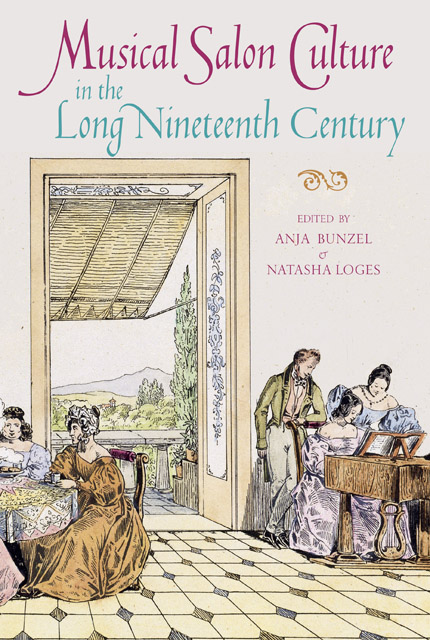3 - Salon Culture in the Circle of Joseph Joachim, or, Composing Inwardness: C. J. Arnold’s Quartettabend bei Bettina von Arnim Reconsidered
Published online by Cambridge University Press: 17 January 2023
Summary
In Carl Johann Arnold’s famous watercolour, Quartettabend bei Bettina von Arnim, Joseph Joachim appears as a faceless Rückenfigur that pulls us from behind into the space of an intimate musical performance. When this depicted scene may have occurred is unclear, although scholars generally assign it to 1854 or 1856. Similarly unclear is exactly which works were performed at Bettina von Arnim’s ‘Gesellschaften’ at her residence ‘Unter den Zelten’ in Berlin. Although Petra Wilhelmy has argued that in the strict sense of the word, Bettina did not direct a salon, contemporary reports of prominent Berliners such as Karl August Varnhagen von Ense, who described gatherings at ‘Unter den Zelten’ where music was performed for groups of culturally minded intellectuals, encourage us to consider further the involvement of one of Bettina’s most cherished musicians – Joseph Joachim. Wilhelmy concedes that if Bettina did not host a typical salon, she did entertain assembled house parties that were interesting, unconventional, and quite heterogeneous, with audiences that ranged from ‘Prussian princes’ to ‘democratic authors’. And, as Wilhelmy adds, music played a large role in the von Arnim house. Nor was Bettina’s ‘salon’ the only one frequented by Joachim. During the Bismarck era, the musician and his wife, Amalie (a mezzo-soprano whom he married in 1863), were guests at the Berlin salon of the Countess Marie von Schleinitz-Wolkenstein, an aristocrat who, much like Bettina and other salonnières, recruited musicians to enrich the cultural offerings of her private social gatherings.
If salon research aims, as one of its goals, to understand a cultural space typically inhabited by women whose voices were often not heard (partly explaining, in this instance, the sparse documentation for Joachim’s participation in von Arnim’s salon), this chapter proposes that Joachim’s relationships with members of this salon and his creative output between the years surrounding Arnold’s painting can shed light on the very concept on which Bettina von Arnim’s social gatherings were based – intimacy. By attempting a reading of correspondence and documents related to Joachim’s interaction with the von Arnims – including a composition – we examine what it meant for him to be involved with the von Arnims and, in turn, what it meant for the von Arnims to be so intimate with the Jewish-Hungarian musician, by then already hailed as one of Germany’s most distinguished violinists.
- Type
- Chapter
- Information
- Musical Salon Culture in the Long Nineteenth Century , pp. 43 - 64Publisher: Boydell & BrewerPrint publication year: 2019

